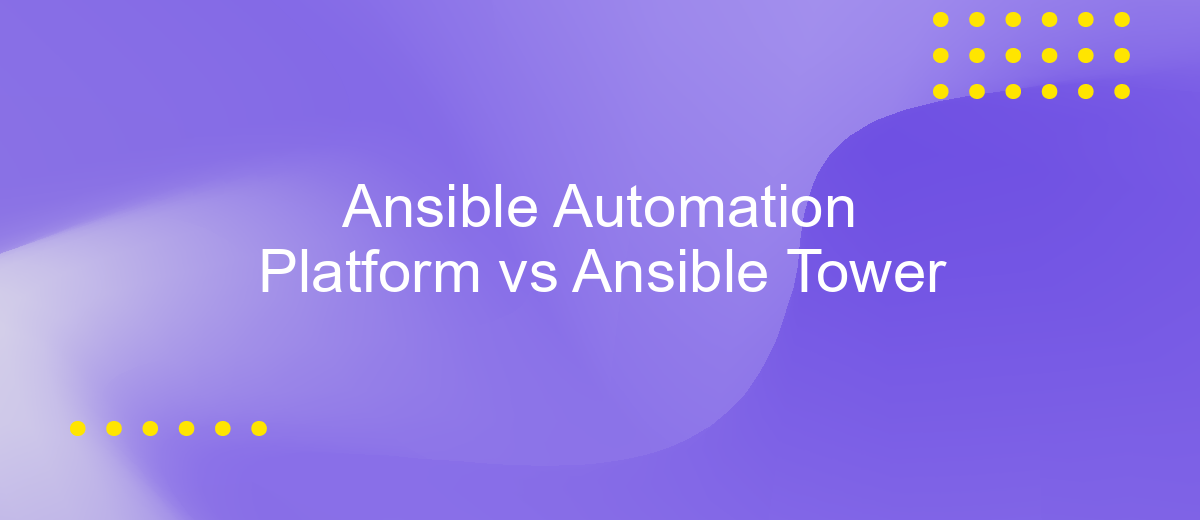Ansible Automation Platform vs Ansible Tower
In the ever-evolving landscape of IT automation, choosing the right tool can significantly impact efficiency and scalability. Ansible Automation Platform and Ansible Tower are two prominent solutions that cater to diverse automation needs. This article delves into the key differences and advantages of each, helping organizations determine which platform best aligns with their operational goals and technical requirements.
Introduction: Ansible Automation for Enterprise
Ansible has emerged as a leading tool for automation in enterprise environments, streamlining complex IT workflows and enhancing operational efficiency. As businesses strive to keep pace with technological advancements, the need for robust automation solutions becomes paramount. Ansible Automation Platform and Ansible Tower are two pivotal components in this landscape, offering enterprises the tools they need to manage and automate their IT infrastructure effectively.
- Ansible Automation Platform: A comprehensive suite designed for large-scale automation, providing a unified experience for orchestrating IT operations.
- Ansible Tower: A centralized control system that enhances Ansible's capabilities, offering a user-friendly interface and additional management features.
Both Ansible Automation Platform and Ansible Tower play crucial roles in empowering enterprises to automate tasks, reduce manual errors, and improve productivity. By leveraging these tools, organizations can achieve seamless integration across their IT ecosystems, ensuring consistent and reliable operations. As enterprises continue to evolve, the significance of automation in driving innovation and maintaining competitive advantage cannot be overstated.
Key Features and Capabilities Comparison

Ansible Automation Platform and Ansible Tower are both pivotal in managing automation tasks, yet they cater to different needs. Ansible Automation Platform offers a comprehensive suite for automating IT operations, providing tools for creating, testing, and deploying automation workflows. It includes features like automation mesh, which enhances scalability and reliability, and automation hub for accessing certified content. In contrast, Ansible Tower, now part of the Automation Platform, primarily focuses on providing a web-based interface for managing Ansible projects, including role-based access control, job scheduling, and real-time job status updates.
When it comes to integration capabilities, both solutions support seamless integration with third-party services, enhancing their versatility. Tools like ApiX-Drive can further streamline these integrations by automating data transfers between various applications, ensuring smooth workflow automation. This is especially beneficial for organizations looking to connect Ansible with CRM, ERP, or other business systems. While Ansible Tower excels in simplifying Ansible operations through a user-friendly interface, the Ansible Automation Platform extends its capabilities, offering a more robust environment for enterprise-level automation.
Scalability, Availability, and Performance

When considering scalability, availability, and performance, both Ansible Automation Platform and Ansible Tower offer robust solutions, yet they cater to different needs. Ansible Tower, as a part of the broader Ansible Automation Platform, provides a more focused approach to managing and scaling automation tasks. It is designed to handle a limited number of nodes efficiently, making it suitable for small to medium-sized environments.
- Ansible Automation Platform is built for enterprise-level scalability, supporting thousands of nodes with ease.
- It ensures high availability through clustering, reducing downtime and enhancing reliability.
- Performance optimization in the Platform is achieved via advanced job scheduling and execution strategies.
In contrast, Ansible Tower alone might encounter limitations as the infrastructure grows, primarily due to its standalone nature. However, it excels in environments where simplicity and ease of use are prioritized over extensive scalability. Ultimately, the choice between the two depends on the specific requirements of the organization, with the Automation Platform offering a comprehensive suite for large-scale operations, while Tower provides a streamlined solution for smaller setups.
Pricing and Licensing Models

When considering Ansible Automation Platform and Ansible Tower, understanding their pricing and licensing models is crucial for making an informed decision. Ansible Automation Platform provides a comprehensive suite of automation tools with a subscription-based model. This subscription includes support, updates, and access to enterprise-grade features, making it suitable for organizations seeking a robust automation solution.
On the other hand, Ansible Tower, which is now a component of the Ansible Automation Platform, offers a more granular approach to automation management. Its pricing is also subscription-based, with options tailored to different organizational needs, ensuring scalability and flexibility in deployment.
- Ansible Automation Platform: Subscription-based, includes support, updates, and enterprise features.
- Ansible Tower: Part of the Ansible Automation Platform, also subscription-based with scalable options.
- Both offer flexible pricing to accommodate varying organizational sizes and requirements.
Ultimately, the choice between Ansible Automation Platform and Ansible Tower depends on your organization's specific needs and budget. Both models offer scalability and flexibility, ensuring that businesses can tailor their automation strategies effectively. By evaluating the features and pricing structures, organizations can select a solution that aligns with their operational goals and financial constraints.
Choosing the Right Solution: Ansible Tower or Ansible Automation Platform
When deciding between Ansible Tower and the Ansible Automation Platform, it's crucial to consider your organization's specific needs. Ansible Tower provides a streamlined way to manage complex IT environments by offering a graphical user interface, role-based access control, and job scheduling. It's ideal for organizations looking for a centralized solution to manage their Ansible playbooks and automate tasks efficiently. However, if your organization requires a more comprehensive solution that includes additional tools and services, the Ansible Automation Platform might be the right choice. It extends the capabilities of Ansible Tower by integrating with other Red Hat technologies, offering a complete automation ecosystem.
For businesses that need to integrate various applications seamlessly, leveraging a service like ApiX-Drive can be beneficial. ApiX-Drive allows you to connect and automate workflows between different applications without extensive coding, complementing the capabilities of both Ansible Tower and the Ansible Automation Platform. By evaluating your automation needs and considering the integration capabilities of services like ApiX-Drive, you can make an informed decision that aligns with your IT strategy and operational goals.
FAQ
What is the primary difference between Ansible Automation Platform and Ansible Tower?
Can Ansible Tower operate independently from Ansible Automation Platform?
How does Ansible Automation Platform enhance the capabilities of Ansible Tower?
Is there a way to integrate Ansible Automation Platform with other tools for enhanced automation?
What are the benefits of using Ansible Automation Platform over just using Ansible?
Time is the most valuable resource in today's business realities. By eliminating the routine from work processes, you will get more opportunities to implement the most daring plans and ideas. Choose – you can continue to waste time, money and nerves on inefficient solutions, or you can use ApiX-Drive, automating work processes and achieving results with minimal investment of money, effort and human resources.

